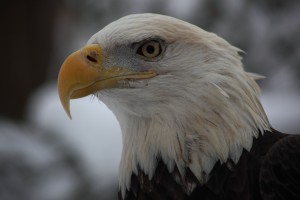The Bald Eagle (Haliaeetus leucocephalus)
The Bald Eagle (Haliaeetus leucocephalus):
Photo by ForestWonder Nature Photography http://www.forestwander.com/2011/05/bald-eagle-face/
The white head and tail feathers of an adult Bald eagle are conspicuous identifying features. Females can weigh 14 pounds with wingspans of 8 feet. Male eagles weigh less, 10 pounds with a wingspan of 6 feet.
At one time its historic range (Alaska and Canada to northern Mexico) supported 500,000 birds. Its numbers declined dramatically when DDT was introduced after World War II to kill mosquitoes and other insects. DDT rendered eggshells of Bald eagles, peregrine falcons and brown pelicans too fragile to survive incubation. Some eagles also died from lead poisoning probably ingested from prey. Since Bald eagles are at the top of the food chain, toxic chemicals are concentrated in the contaminated fish or other ingested prey. Habitat destruction and illegal shooting also played a crucial role in their decline. From a low of 417 breeding pairs in 1963, populations in the lower 48 states grew to a high of
9,789 pairs today. Habitat protection provided by the Endangered Species Act, the Environmental Protection Agency’s banning of DDT, and other conservation actions sparked a dramatic recovery of bald eagles. During winter, migrants are found near large reservoirs and rivers in Kansas.
Bald eagle nests have increased in Kansas since 1989. A bald eagle’s can lift a 4-pound fish out of the water. An eagle’s vision is at least four times that of a person with perfect vision. In 2007, the U. S. Fish & Wildlife Service announced the recovery of the Bald eagle and removed it from the threatened and endangered species lists. Bald eagles will continue to be protected by the federal Bald Eagle Protection Act and the Migratory Bird Treaty Act that prohibit killing, selling, or otherwise harming eagles, their nests, or eggs.

